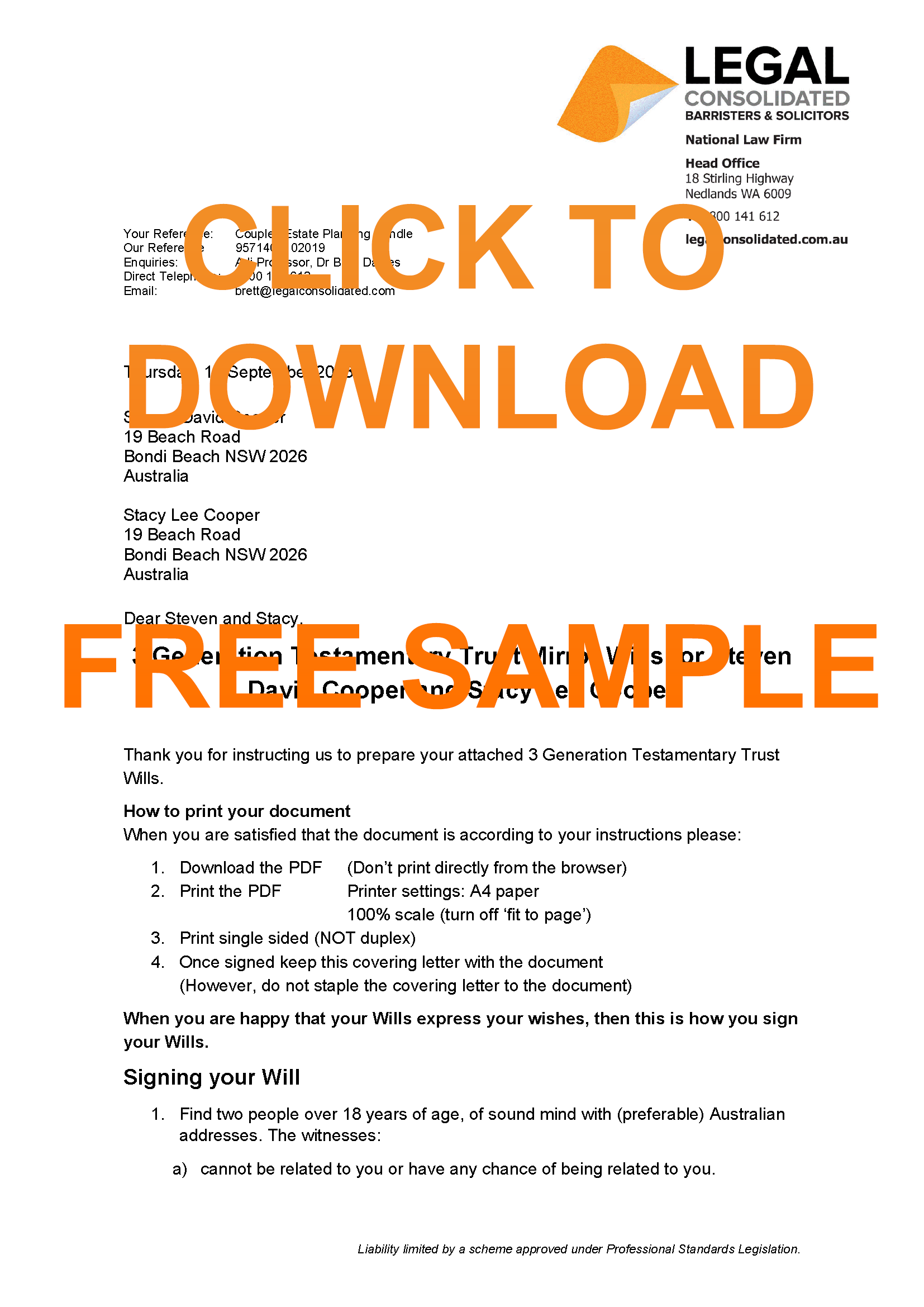Unit Trust Vesting deed – how to wind up a unit trust
Unit Trust Vesting deed for Centrelink?
You have finally retired and applied to Centrelink for a pension. Unfortunately, Centrelink takes issue with the fact that you have an old unit trust that was created 30 years ago. It hasn’t been used for years. There is no money left in it. The unit trust has a nil value. It has no assets and no debts. What can you do? To formally wind up a unit trust build this Unit Trust Vesting deed kit on our law firm’s website.
Vesting a Unit Trust you don’t want?
You have an old Unit Trust. Your accountant or financial planner suggests that it is more trouble than it is worth. Vesting a Unit Trust is simple and straightforward. Just build this Vesting a Unit Trust deed kit to wind up a unit trust.
Why wind up a Unit Trust?
• The Unit Trust has achieved its original purpose
• It has no assets (if it has debts do a Debt Forgiveness Deed first)
• The Unit Holders of the Unit Trust don’t want to continue
• The Unit Trust has reached its vesting date
How does the Unit Trust Vesting deed wind up a Unit Trust?
This is how you wind up a Unit Trust Deed:
1. Distribute any capital that is left to the Unit Holders
2. Build a Debt Forgiveness Deed to forgive loans owed to Unit Holders and related parties
3. Your Accountant prepares any outstanding tax returns
4. Build and sign both the Unit Trust Vesting deed and the minutes
Build this Unit Trust Vesting deed pack on our law firm website. You get:
1. Vesting a Unit Trust deed (just print and sign)
2. Minutes for your Accountant’s due diligence file
3. Law firm Letter of Advice on winding up your Unit Trust
ATO’s position – Taxation Ruling TR 2018/6 when ending a Unit Trust
Taxation Ruling TR 2018/6 sets out the views on the income tax consequences of a trust vesting. Our deed complies with the ruling.
A trust’s ‘vesting’ or ‘termination’ date is the day on which the beneficiaries’ interests in the property of the trust become ‘vested in interest and possession’.
Have a look at the Sample document, training videos and hints. They help you as you build the Unit Trust Vesting Deed.
Vesting a Unit Trust for Centrelink
Q: Your “Vesting Deed” for Family Trust states it is Centrelink compliant. Is the ”Vesting Deed” document for the Unit Trust also Centrelink compliant?
Y: It is generally dormant Family Trusts that cause the greatest grief. This is when you or your parents try to get Centrelink benefits. But the Unit Trust Vesting deed is also compliant and works with Centrelink.
It provides the evidence required by Centrelink.
My old Unit Trust deed already allows the winding up of the Unit Trust
Q: My Unit Trust Deed already confers on the Unit Holders (in my case a Sole Unit Holder) the power to terminate the Unit Trust at any time. Therefore, what additional benefit does your Unit Trust Vesting Deed pack provide?
A: The Unit Trust Vesting pack contains five documents. One of them is a Unit Trust Winding up a Deed. But this Unit Trust Winding up deed does a lot more than just amend the old Unit Trust deed to allow for a winding up.
You are correct. Most Family Trust deeds and Unit Trust deeds already have the power to end the trust. The Deed of Variation to wind up a Unit Trust contains many things. This includes expressly allowing you to terminate the Unit trust and the process to follow.
Also, often the vesting powers in the old trust deed do not allow ‘earlier’ vesting. Or the old deed requires a vesting process which may no longer be sanctioned or best practice. The Unit Trust winding up pack complies with the ATO’s latest rulings.
Further, the power to end the trust in the old trust deed is only part of the process. The Unit Trust vesting pack contains five documents:
- Law firm letter of Advice on ending the Unit Trust:
- signed by a partner of our law firm, on our law firm letterhead
- setting out the process and tax consequences of the winding up
- confirmation and statement that there is no resettlement for tax purposes
- confirmation that the Unit Trust is authorised to be ended in this manner set out in the Unit Trust winding up kit
- Capital Gains tax issues are addressed
- what to do with the capital and assets in the Unit Trust in compliance with the ATO
- when a Unit Trust final tax return is required and the wording the ATO requires
- Unit Trust Vesting Minutes:
- containing the required resolutions to end the Unit Trust
- required by your accountant’s due diligence file
- Vesting of a Unit Trust Deed:
- updating the Unit Holders and Unit Holder Trustee, in consequence of any audit by the ATO
- allowing earlier winding up of the Unit Trust
- augmenting the Unit Trust’s Trustees powers to allow all things necessary to vest and terminate the Unit Trust
- no ‘partnership’ relationships to reduce the threat of unit holders being joint and severally liable for the winding up
- Checklist to end a Unit Trust:
- Step-by-step guide
- Unit Trust Certificate of Vesting
The old Unit Trust Deed already fully sets out the process and authorises the ending of the Unit Trust
Q: The old Unit Trust Deed confers on the Trustee a wide power to amend any provisions of the Trust Deed. This includes the Vesting Date. It also sets out how the Unit Trust is to be terminated. What additional benefit does your Unit Trust Vesting Deed pack provide?
A: The Unit Trust was created by a Deed. Entities and trusts created by a deed should be ended by a deed. The other method to use is to end the Unit Trust via Minutes. However, few accountants and lawyers would recommend ending a trust via only minutes. And, I have never known an accountant or lawyer courageous enough to put in writing that minutes are enough.
Instead, in years to come, if the Family Court, Bankruptcy Court, Centrelink or the ATO come to review the affairs of the Unit Trust then you have the documentation. This is signed off by us, as your lawyers.
Our Unit Trust vesting pack follows best practice. It complies with the ATO’s latest rulings. It is for clients that like to sleep at night, and not take risks or shortcuts. The Unit Trust vesting pack provides peace of mind.
Best to lodge the final Unit Trust tax return after the Unit Trust Vesting pack is signed
Q: Our accountant prepared the tax return for the Unit Trust for the financial year that just ended. He intends to notify ATO the Unit Trust is not lodging tax returns in the future. We now need to build the Unit Trust Vesting pack. Is it necessary to prepare a return for the period for the following financial year? Or can we simply rely on the tax return for last year’s financial year?
A: The best practice is to sign all the documents relating to the Unit Trust Vesting Deed and then lodge the final Unit Trust tax return. But if the final Unit Trust tax return has already been correctly lodged then you do not need to do another one. But you do need to let the ATO know that the Unit Trust is finished. Our letter of advice sets out how the accountant does this.
To end a Unit Trust get your balance sheet to nil
Q:. Our accountant has financial statements for the Unit Trust for the last financial year. If we wish to use your Unit Trust Vesting Deed pack is it necessary to prepare financial statements for the following financial year? Or can we simply rely on the financial statements for the last financial year?
A: A balance sheet (statement of financial position) provides a snapshot of your assets and liabilities. It shows the Unit Trust’s net worth. This is at a single point in time. This is unlike other financial statements. Such as profit and loss reports. These only give information about your Unit Trust over some time
The ATO is not so interested, from a CGT point of view, as to financial statements. Rather it wants to see a Unit Trust balance sheet showing zero. Before you wind up your Unit Trust you need to have your accountant prepare a Balance Sheet showing the Unit Trust has (or will have) no assets.
Who signs the Unit Trust winding up minutes?
Q:. In your FAQ section for the Unit Trust Vesting Deed, you state as to the Minutes: “Pass a resolution stating the that the trust is vested (terminated)”. Two questions:
- Who needs to pass this resolution? The Trustee or the Sole Unit Holder or both?
- Are these Minutes included as part of your Unit Trust vesting package?
A: The minutes are in the Sample. Have a look at the Sample to see the answer to that question. And, of course, that Minute is in the Unit Trust winding up pack. Have a look at the Sample for what you get.
How do I get free legal advice when building the Unit Trust vesting deed?
Start building the Unit Trust Vesting Deed. Read the many hints for each question. Answer as many questions as you can. And then telephone the law firm for a good chat.
We have been in the business of winding up Unit Trusts deeds since 1988. Your ‘unique’ questions about your individual circumstances regarding the winding up of your Unit Trust may already be addressed in the many hints you can read during the building process.
Free Centrelink tool kit
Free resources empowering you to deal with Centrelink:
- Centrelink attacking innocent grandparents – what we do for our children
- Wind up Family Trusts
- Replacing the Appointor in a Family Trust – succession planning for a person wanting Centrelink
- Company to replace pensioner as trustee of a Family Trust
- Can beneficiaries disclaim a trust distribution?
- Abandon a gift in a Will to keep the pension?
- What to do before the end of year financial year – to appease Centrelink
- Centrelink compliant Power of Attorney – keeps your family in control, not Centrelink
- 3-Generation Testamentary Trust Wills – beneficiaries retain Centrelink benefits in your Will
- Special Disability Trust – to avoid Centrelink deprivation rules
Why should I wind up a Unit Trust?
- The Unit Trust has achieved its original purpose
- It has no assets
- The Unit Trust has reached its vesting date
What do I need to do to terminate the Unit Trust?
- The capital of the trust must be distributed in accordance with the Unit Trust deed.
- The Trustee must satisfy any existing liabilities including any existing or future
taxation liabilities that arise as a result of the termination of the trust. - The Trustee must pass a resolution determining that the trust is to be vested (terminated).
- The final accounts of the trust, including a final tax return, must be prepared.
Once this is done, you can build our Deed of Vesting of a Unit Trust. You build a set of documents to vest and close the Unit Trust.
After building this document on our website you are emailed:
1. Unit Trust – Deed of Variation of Vesting
2. Minutes
3. Law firm Letter of advice
What do I need to do to terminate the trust?
- The capital of the trust must be distributed by the trust deed.
- The Trustee must satisfy any existing liabilities of the trust. This includes any existing or future
taxation liabilities that arise as a result of ending the trust. - Pass a resolution stating that the trust is vested (terminated).
- Your Accountant prepares final Unit Trust accounts, including the final tax return.
- Build this document
To wind up a Unit Trust, we need to first identify it. We do this by referring to:
- The Unit Trust’s name
- Date the Unit Trust Deed, that established the Unit Trust, was signed
Every Unit Trust has a name. Sadly, they are generally quite boring. E.g. Smith Unit Trust, named after Mr Smith.
The Unit Trust name is a ‘nickname’. It is not registered anywhere. It just helps you and your accountant identify your Unit Trust.
Take out your Deed of Trust that first started your Unit Trust. Have a look at the front cover. It often has the name of your Unit Trust. It repeats in the body of the Deed as well. Check any subsequent Deeds of Variation, to make sure that your Unit Trust didn’t change its name.
Be careful to not confuse the Unit Trust name with your Trustee. Your Trustee (e.g. XYZ Pty Ltd) is not your trust name
Because you are building your Unit Trust Vesting deed on our law firm’s website you:
1. retain legal professional privilege
2. law firm PI insurance protects you
3. receive legal advice
4. by law have us act in your best interests, over our own
Only a law firm provides the above.
‘Resettlement’ happens when you alter the Trust to such a level that it becomes a new trust. You would then suffer Capital Gains Tax, Stamp Duty and other issues.
As a taxation law firm, we ensure that you do not suffer a ‘resettlement’ by applying:
1. Clark’s case
2. High Court decision in FC of T v Commercial Nominees [2001] HCA 33
3. ATO’s withdrawal in 2012 of its Statement of Principles on the Creation of a New Trust. And its release of the ATO’s Decision Impact Statement
Business Structures to be wound up or got rid of old structures
Family trust
- Family Trust Deed – watch the free training course
- Family Trust Updates:
- Everything – Appointor, Trustee & Deed Update
- Deed ONLY – only update the Deed for tax
- Guardian and Appointor – only update the Guardian & Appointor
- Change the Trustee – change human Trustees and Company Trustees
- The company as Trustee of Family Trust – only for assets protection?
- Bucket Company for Family Trust – tax advantages of a corporate beneficiary
Unit trust
- Unit Trust
- Change Unit Trust Trustee – replace the trustee of your Unit Trust
- Company as Trustee of Unit Trust – how to build a company designed to be a trustee of a Unit Trust
Corporate structures
- Partnership Agreement – but what about joint liability?
- Incorporate an Australian Company – best practice with the Constitution
- Upgrade the old Company Constitution – this is why
- Replace lost Company Constitution – about to get an ATO Audit?
- Independent Contractor Agreement – make sure the person is NOT an employee
- Service Trust Agreement – operate a second business to move income and wealth
- Law firm Service Trust Agreement – how a law firm runs the backend of its practice
- Medical Doctor Service Trust Agreement – complies with all State rules, including New South Wales
- Dentist Service Trust Agreement – how dentists move income to their family
- Engineering Service Trust Agreement – commonly engineers set up the wrong structure
- Accountants Service Trust Agreement – complies with ATO’s new view on the Phillips case


